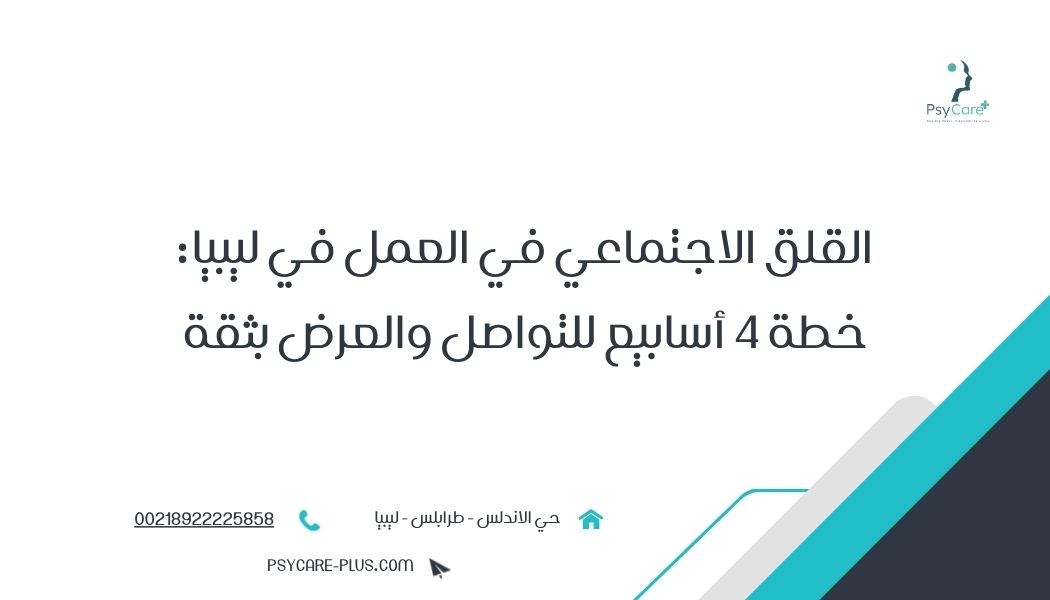Social Anxiety at Work in Libya: A 4-Week Plan to Speak Up and Present with Confidence
Practical CBT + Graded Exposure + Ready-to-Use Scripts for Meetings, Calls, and Presentations

Social Anxiety at Work in Libya: A 4-Week Plan to Speak Up and Present with Confidence
Note: This guide is for education, not emergencies. For immediate risk, contact local emergency services. For structured care, book via Therapists, learn about us at Who We Are, explore more on the Blog, or message us via Contact Us. Book easily: PyCare Plus – Google Play.
Intro: Shyness or Social Anxiety?
Pre-meeting jitters are normal. Social anxiety at work shows up when fear of judgment or “being exposed” stops you from speaking, asking, presenting, or even casual chatting—hurting performance and growth. The loop: catastrophic thoughts → body arousal → safety behaviors (over-prepping, camera off, reassurance) → short relief → stronger anxiety.
Why CBT helps
Break the loop with three levers:
-
Body regulation (4–6 breathing/grounding),
-
Cognitive re-balancing,
-
Graded exposure with reassurance-blocking.
Common workplace triggers
Intros, unmuting/camera on, asking your manager, phone calls with clients, 1–5-minute updates, small talk, emailing senior folks. Pick 5 “hot” ones to target first.
Quick core tools
-
4–6 breathing: inhale 4s/exhale 6s × 6–8.
-
3-2-1 grounding: 3 see, 2 touch, 1 hear.
-
Language swap: “Natural nerves… I’ll read my opener, then continue.”
-
Reassurance limits: max two pre-send reviews by one person.
Work Exposure Ladder (easy → hard) — example
Rate anxiety 0–10; start at 3–4/10:
-
Clear good-morning to a colleague (2 days).
-
One-line comment in an internal meeting (2 days).
-
One short question in a cross-team meeting (3 days).
-
2–3-minute call with an internal client instead of emailing (2 days).
-
60-second summary of your work in the weekly meeting (3 days).
-
3-minute mini-presentation with two slides (1 week).
Progress rule: two consecutive runs ending at ≤3/10 → move up. During each step: 4–6 + no extra reviews/apologies.
Ready-made scripts
1) Meeting opener
-
“Good morning, this is [Name] from [Team]. Quick update on [task].”
2) Clear question
-
“Quick clarification: is the deadline Thursday end-of-day?”
3) If you lose your thread
-
“Let me return to the key point: we need [A] before [B].”
4) Brief email (cut re-writes)
-
Subject: Brief Update – [Task/Date]
-
Body: 1) Status 2) Blocker 3) Ask by [date]
5) Asking for help (without over-apologizing)
-
“I need a 10-minute review from someone experienced with [X].”
Pitfalls that fuel anxiety
Infinite prep, perma-off camera, repeated apologies, constant pre-send reassurance. Taper each one.
4-Week plan (customizable)
Week 1 — Calm & clarity
-
4–6 twice daily + before social steps.
-
Build a 5–7 rung ladder.
-
Do rungs 1–2 daily with reassurance-blocking.
-
Meeting log (2 minutes): context/anxiety before–during–after/blocked ritual/balanced line.
Week 2 — Generalize & increase
-
Rungs 3–4.
-
Camera on for first 3 minutes of one internal meeting.
-
Use the one clear question script in every meeting you join.
-
Emails: max two reviews before send.
Week 3 — Core behaviors
-
Short internal/partner call (rung 4–5).
-
60-second weekly summary.
-
External focus: look at slides/faces, hide self-view if needed.
Week 4 — Mini-presentation & relapse prevention
-
3-minute mini-talk with two clear points + next step.
-
Maintenance: two social actions/week (question/comment/call).
-
Early-warning list: if over-prepping/reassurance returns → step down one rung, repeat.
Progress markers: lower peaks, shorter prep, more frequent participation, feedback on clarity/conciseness.
Hybrid/remote specifics
-
Pre-meeting routine: 4–6 × 4 + opener on a sticky note.
-
Hide self-view to reduce self-monitoring.
-
If you blank: 4–6, “Key point is…,” read your first line.
-
Post-meeting: log one win + one tweak—no mental replays.
Handling a visible mistake
-
“Thanks for the catch. Correction: [line]… moving on.”
Short, specific, no self-attack—then continue.
FAQs
Camera always on? No—gradually (3 minutes then 10).
Freeze moment? 4–6 + anchor line + first sentence on your notes.
Medication? Case-by-case with a psychiatrist within a broader plan.
Start now
-
Choose your clinician: Therapists
-
Download & book: PyCare Plus – Google Play
-
Who we are: Who We Are
-
More skills: Blog
-
Questions? Contact Us
One small voice in each meeting beats months of silence. Start with a single clear question today.




